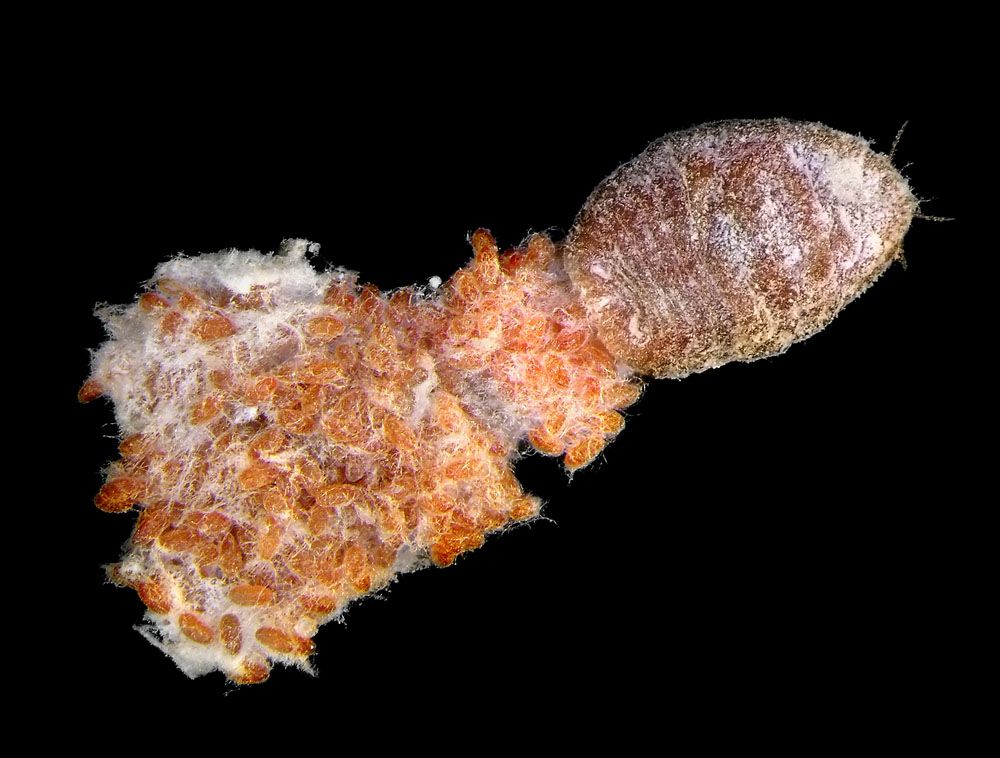
Pink Hibiscus Mealybug – Maconelliocuccus hirsutus
Pink Hibiscus Mealybug – Maconelliocuccushirsutus
Common Name: Pink Hibiscus Mealybug
Latin Name: Maconelliocuccushirsutus
Appearance:
Female and male mature hibiscus mealybugs are about a one-eighth inch (3 mm) long. Female bodies are pink with a white waxy coating. They have no wings and resemble ovoid forms coated in a mound of white mealy wax. Males have a pair of wings and two long waxy tails and can fly. The adult female lays eggs in a white wax egg sack, generally in clusters on the host plant’s twigs, branches, and bark, as well as on the plant’s leaves and terminal ends. Eggs are orange at first but become pink as they mature. The development of an egg takes between 3 and 9 days. . Eggs are tiny, measuring 0.3 to 0.4 mm in length and containing up to 654 eggs per sack. The hibiscus mealybug disperses most easily by wind during its egg stage. The wax that adheres to each egg also allows for passive transport by animals or humans. In the absence of the male, reproduction can occur through parthenogenesis.
Host plant:
Its extensive host range exceeds over 200 perennial and annual plant species, many of which are essential in agriculture and as ornamentals.
Territory:
.This pest is found throughout most of the world’s tropical regions, including Asia, the Middle East, Africa, Australia, and Oceania.
Damages caused by Pink Hibiscus Mealybug:
The pink hibiscus mealybug is more than an agricultural issue. This bug will wreak havoc on beautiful plants in yards and parks. Pink hibiscus mealybug can be found on numerous plant stems, leaves, buds, fruit, and roots. It feeds on the delicate tissues of many plant species and injects poisonous saliva that causes the leaves to curl and distort. The strength of the afflicted plant determines the extent of feeding damage; young and weak trees are more vulnerable. The mealybug typically infests young twigs on the hibiscus, causing distorted terminal development owing to internode shortening, deformed leaves, and thicker twigs. Cotton’s developing components are attacked, resulting in clumpy growth.
Life history and habits:
The mature female is about 0.12 in. (3 mm) long, wingless, and covered with white, flocculent wax on the dorsal side. It has two short, unobtrusive caudal filaments and no lateral wax filaments. Both the female’s body and fluid are reddish. The female secretes a white cotton-like egg mass that is uneven in form and contains 300 to 600 pink eggs—the eggs hatch into first-instar nymphs, or pink crawlers. The pink eggs and crawlers are visible when the egg mass is teased. In tropical settings, one generation takes roughly 30 days to complete. Adult male mealybugs are reddish brown, with one pair of wings and two long wax caudal filaments. Males lack functioning mouthparts. Males do not feed and only live for a few days. Unmated females emit a sex pheromone (attractive aroma) that attracts PHM men for mating.
